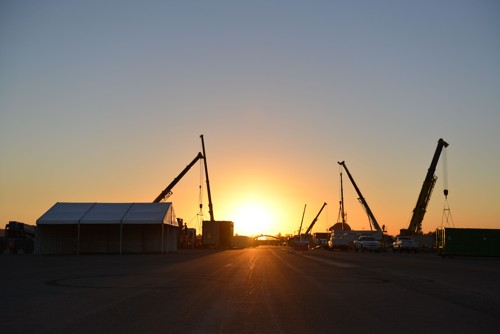
Solar Decathlon 2013 has just begun
 |
The Solar Decathlon begins in Orange County from scratch. Since its first year (2002), the competition has been held every two years in Washington, DC. This year, the solar houses will be exhibited for the first time in the area of the former El Toro Marine Corps Air Station. Now, only the reconstructed hangars and concrete runways remind us of its history. A solar town is currently being built on one of them. The local government is working on the remediation of the entire area, which is set to transform into an ecological recreational park in the future.
We estimate that up to 700 students will participate in the construction of all the competition houses. According to the first joint meeting, our team is among the larger ones. Including friends and wives who are taking care of our accommodations, we are a total of 32. American teams transport their buildings in several essentially completed parts, which will be connected and put into operation. We are awaiting assembly from the ground up to the last screw.
We are participating in the competition for the first time, and we only knew the construction of the solar town from photographs. It is an enormous experience. 19 construction sites are spread over precisely defined building plots on both sides of the main pedestrian pathway. Trucks loaded with pieces of houses and shipping containers distribute the cargo around the construction sites. Surprisingly smoothly. Most teams use cranes for unloading, which dominate the entire area. Various types of forklifts assist with handling. The organizers move around the construction sites in style, in golf carts.
Each team has its own assembly technique and differently arranged construction site. Most of the competition houses are built by the students themselves, often with the help of a few experienced workers. Houses that teams hire a construction company to build are the exception. While observing the neighboring construction site where they are preparing formwork for the concrete foundation, we are amazed at how many different original methods can be devised to anchor the structure to the concrete runway.
We have planned the assembly of AIR House for five days. On the first day, we managed to outline the construction, anchor the foundation piers, set the foundation frames, anchor the technology box into them, and install the floor panels. We are working in two shifts. The morning crew starts at seven in the morning and is replaced by the second crew in the afternoon, which ends at two in the morning. We can continue working only after a five-hour break. Fortunately, otherwise, we would probably be working the entire day nonstop.
The time we save in construction, we want to use to operate and fine-tune the technology and test how the house behaves in an environment that we have only simulated in the computer so far. It will be exciting, but the first day got us off to a good start, and I’m looking forward to how it will continue.
Keep your fingers crossed for us and follow our website and social media.
The English translation is powered by AI tool. Switch to Czech to view the original text source.
1 comment
add comment
Subject
Author
Date
nemusíme jen držet palce, můžem i hlasovat
Veronika Trachtová
07.10.13 10:32
show all comments
Related articles
0
08.07.2013 | ČVUT will unveil a unique intelligent house, which will compete in the USA in October
0
17.06.2013 | Exhibition AIR HOUSE – ATTENTION CONSTRUCTION!
0
07.02.2012 | Czech students created a solar house that impressed in the USA
1
01.02.2012 | Students of ČVUT in the final of the Solar Decathlon global competition











